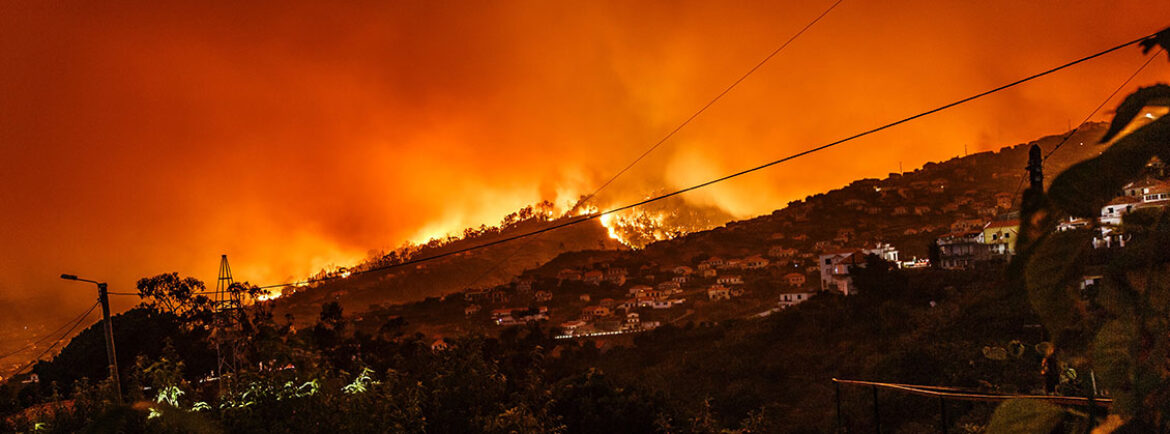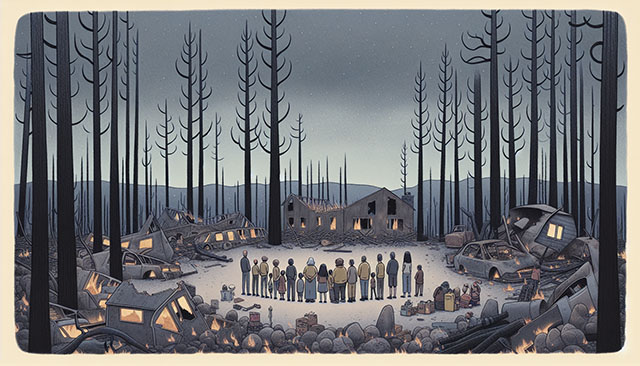
California Wildfire: Paradise
One of the deadliest wildfires in California history, survivors are now fighting for justice against PG&E
The PG&E Camp Fire lawsuit emerged in the wake of the devastating 2018 fire, which Cal Fire identified as being sparked by PG&E’s faulty electrical transmission lines. The impact of this disaster was catastrophic, leaving families grappling with loss, displacement, and overwhelming trauma. This guide aims to provide essential information on the claims and settlement process, empowering victims who have suffered immeasurable pain and hardship in their pursuit of compensation and justice.
Key Takeaways
- The PG&E Camp Fire lawsuit stems from the devastating wildfire caused by negligent maintenance of electrical transmission lines, resulting in over 86 fatalities and significant property damage.
- Victims are pursuing claims for various damages including wrongful death, personal injuries, and property loss, with a focus on holding PG&E accountable for its role in the disaster.
- The Fire Victim Trust agreement has been established to provide financial compensation and support for recovery, disbursing billions in settlements, and increasing pro rata payment percentages to aid fire survivors.
- The Camp Fire settlement includes a $1 billion agreement made by PG&E with 14 public entities, ensuring significant financial compensation to Paradise and Butte County, emphasizing the importance of victims receiving their rightful payments.
Overview of the PG&E Camp Fire Lawsuit

An illustration depicting the aftermath of the PG&E Camp Fire lawsuit, showing fire victims and destroyed homes.
The Camp Fire ignited near Paradise, California, on November 8, 2018, and quickly became one of the most devastating fires in recent memory. It consumed over 153,000 acres, destroyed more than 12,000 structures, and claimed the lives of at least 86 people. The cause? Faulty electrical transmission lines owned by Pacific Gas and Electric Company (PG&E). This catastrophic event has led to a series of lawsuits against PG&E, seeking compensation for the immense losses and damages suffered by the fire victims in Northern California.
As of early 2019, PG&E was aware of over 100 complaints from more than 4,200 plaintiffs related to the Camp Fire.
These lawsuits are primarily aimed at seeking compensation for:
- wrongful death
- personal injuries
- property loss
- other legal damages
The sheer scale of the devastation and the number of affected individuals underscore the importance of these legal actions in providing relief and justice to the Camp Fire victims.
The lawsuits against PG&E are not just about financial compensation; they are about holding the company accountable for its role in one of the most destructive fires in California’s history. Fire survivors, through their legal claims, are seeking to rebuild their lives and communities.
This overview sets the stage for a deeper exploration into the legal grounds for these claims and the impact on the wildfire victims.
Background on the Camp Fire
The Camp Fire was a devastating wildfire that erupted in November 2018 in Butte County, California. It stands as the most destructive wildfire in the state’s history, tragically claiming the lives of 85 people and obliterating over 18,000 structures. The fire was ignited by a faulty electrical transmission line owned and operated by Pacific Gas and Electric Company (PG&E). Over the course of 17 harrowing days, the land was scorched more than 153,000 acres, leaving a trail of destruction in its wake.
The impact on the community was profound. Many residents lost their homes, businesses, and livelihoods, facing an uncertain future. The Camp Fire not only devastated the physical landscape but also left deep emotional scars on the survivors. Understanding the background of this catastrophic event is crucial as we delve into the legal battles.
Legal Grounds for the PG&E Camp Fire Lawsuit
The legal grounds for the PG&E lawsuit are rooted in the various claims filed by those displaced, injured, and affected by the fire. These claims highlight the significant role PG&E played in causing the fire and the subsequent damages. The legal actions taken against PG&E encompass a range of issues, from negligence to injust death, each aiming to provide fire victims with the justice and compensation they deserve.
Understanding the foundation of these legal claims is vital. They are primarily based on PG&E’s failure to properly maintain its power lines and electrical transmission equipment. This negligence is a key factor in the devastating fires that ensued, leading to numerous lawsuits.
Negligence and Wrongful Death Claims
Negligence claims against PG&E are primarily centered on the company’s failure to properly maintain its power lines, which contributed significantly to the Camp Fire. Numerous lawsuits have been filed, alleging that PG&E’s negligence in maintaining its power lines directly led to the tragic events of November 8, 2018. These legal claims are not just about the physical damage caused by the fire but also about the personal injury and emotional distress suffered by the victims.
Wrongful death claims are a poignant aspect of these lawsuits. At least 86 people lost their lives in the Camp Fire, and their families are seeking justice for their untimely deaths. These claims are often accompanied by personal injury claims, as many victims also suffered severe emotional distress and trauma.
Legal fees and attorneys fees are typically only incurred if the claim is successful, as most law firms work on a contingency fee basis for these types of cases.
Role of Electrical Transmission Lines Owned by PG&E
The role of PG&E’s transmission lines in causing the Camp Fire cannot be overstated. Cal Fire’s investigation concluded that the fire was sparked by PG&E’s lines. Specifically, two distinct ignition points were identified as being caused by PG&E’s equipment, indicating significant issues with their maintenance and operation.
Before the fire started, PG&E had received reports from a woman about sparking, downed power lines, highlighting potential issues with their equipment. Despite these warnings, the necessary preventive measures were not taken, leading to the catastrophic events of the Camp Fire.
This negligence has been a focal point in the lawsuits filed against PG&E, as it underscores the company’s failure to ensure the safety and reliability of its electrical lines.
Impact on Camp Fire Victims

An illustration representing the impact of the Camp Fire on victims, highlighting the struggles of fire survivors.
The impact of the Camp Fire on its victims has been profound and far-reaching. The fire caused significant personal injury, emotional distress, and financial losses for many. The lawsuits filed by the victims are seeking compensation for a wide range of damages, including death by negligence, property loss, and lost wages. The financial strain of recovery and rebuilding is immense, and the proposed settlement aims to provide the necessary support to facilitate this process.
The settlement, a $1 billion agreement made by PG&E with 14 public entities, is significant in providing financial award to victims, ensuring they receive their rightful payments rather than just local governments.
Personal injury and emotional distress are among the most challenging aspects of the aftermath of the Camp Fire. Legal actions can help victims address often reported severe emotional distress. Compensation for emotional trauma is an integral part of the claims process, and it is assessed alongside other personal injury claims. The psychological impact of losing homes and loved ones cannot be understated, and seeking justice through legal means is a way for victims to find some measure of solace.
Property damage and lost wages are also significant concerns for Camp Fire victims. The destruction of property, including homes and personal belongings, has left many in financial ruin. Additionally, the disruption of employment and the loss of income have compounded the financial hardships faced by the victims. Legal claims for these damages are crucial in helping victims rebuild their lives and regain financial stability.
Personal Injury and Emotional Distress
The Camp Fire led to at least 85 fatalities and destroyed nearly 14,000 structures. For the survivors, the emotional distress and personal injuries have been overwhelming. Victims often report severe emotional consequences, including anxiety, depression, and post-traumatic stress disorder (PTSD). Legal actions taken by the victims seek to address these injuries and provide compensation for the emotional trauma experienced.
The purpose of the trust funded by the PG&E settlement is to compensate tort claimants and help victims rebuild their lives. Payments made for personal physical injuries or related emotional distress from settlements are generally not subject to tax. Additionally, settlement awards for the destruction of a principal residence can be tax-exempt if specific ownership and usage criteria are met.
Reinvesting settlement funds in replacement property may also allow for the deferral of tax liabilities on those amounts.
Property Damage and Lost Wages
Many fire victims experienced not only the destruction of their property but also significant financial losses from missed work opportunities. The lawsuits filed seek damages for these lost wages, as the fire’s disruption of employment has had a lasting impact on the victims’ financial stability. Claiming lost income is a crucial step in helping victims recover from the financial devastation caused by the fire.
Similarly, the North Bay fires in 2017 led to substantial legal and financial repercussions, including settlements and claims management, particularly involving PG&E and the establishment of a Fire Victim Trust to compensate affected individuals.
The destruction of property, including homes, businesses, and personal belongings, has left many victims in dire financial straits. The legal claims filed against PG&E aim to provide compensation for these property losses, allowing victims to rebuild their homes and lives.
The hard work and resilience of the fire survivors are evident in their pursuit of justice and compensation through the legal system.
Filing a Camp Fire Claim

An illustration of the process of filing a Camp Fire claim, showing a step-by-step guide for fire victims.
Filing a Camp Fire claim is a critical step for victims seeking compensation for their losses. The process is designed to be accessible, with no required legal fees to be paid upfront. Claimants do not incur any upfront fees when hiring an attorney, as they typically work on a contingency fee basis. This approach ensures that victims can pursue their claims without the burden of immediate financial costs.
The eligibility criteria for filing a Camp Fire claim are straightforward. Individuals may seek restitution for losses incurred as a direct consequence of the Camp Fire. However, to be eligible for compensation, claimants must have timely submitted a Proof of Claim by December 31, 2019.
Claims can be filed for various types of damages, including personal injury and property loss, against PG&E.
Eligibility Criteria for Camp Fire Claims
To be eligible for a Camp Fire claim, individuals must have experienced losses directly resulting from the fire. This includes personal injury, property damage, emotional distress, and lost wages. Claimants must have also submitted a Proof of Claim by the deadline of December 31, 2019, to be considered for compensation. The timely submission of this proof is crucial in ensuring that the claims are processed and evaluated accurately.
Various types of damages can be claimed against PG&E, including those related to personal injury and property loss. The eligibility criteria are designed to ensure that all victims who meet these requirements can seek the compensation they deserve. This process is a vital part of the overall effort to provide justice and financial relief to those affected by the Camp Fire.
Steps to File a Camp Fire Claim
Filing a Camp Fire claim involves a series of steps designed to ensure that all necessary information is provided for the claims process. The first step is to complete a Claims Questionnaire, which initiates the process for compensation. This questionnaire must be filled out accurately and submitted as part of the claims process. Supporting documents, such as proof of loss and identification, must also be uploaded along with the Claims Questionnaire.
The Claims Resolution Procedures outline the specific documentation required for filing a claim. This includes providing detailed information about the losses incurred and any evidence supporting the claim. The process for filing claims against PG&E includes a clearly defined timeline for submission and processing, ensuring that all claims are handled efficiently and fairly.
The Role of the Fire Victim Trust
The Fire Victim Trust was established to assist survivors of various California wildfire victims. Its primary purpose is to compensate wildfire victims for their losses and help them rebuild their lives. To date, the Trust has disbursed over $12.78 billion to compensate victims for various damages caused by the Camp Fire. The Trust began accepting claims on July 1, 2020, and has been a critical resource for those affected by these devastating fires.
The Trust’s role extends beyond mere financial compensation. It aims to keep fire survivors informed about their claims and any updates related to the settlement process. Trustees and claims personnel actively collaborate to finalize claims processing, ensuring that victims receive the support they need as promptly as possible.
The Trust’s establishment and ongoing efforts highlight the importance of structured financial aid in the aftermath of such catastrophic events.
Purpose and Function of the Fire Victim Trust
The Fire Victim Trust was created to provide financial compensation to wildfire victims, ensuring they have the resources needed to recover from their losses. PG&E committed to paying victims’ claims through the Trust as part of its reorganization plan. As of November 1, the Trust has paid out over $5.36 billion in settlement awards to claimants. The Trust received a total of $6.75 billion, with installment payments planned to ensure continuous support for the victims.
In total, the Trust has provided over $1 billion specifically to fire survivors. This significant financial support has been crucial in helping victims rebuild their homes and communities.
The Trust also ensures that claimants are kept informed about the status of their claims and any relevant updates, emphasizing transparency and communication throughout the process.
Pro Rata Payment Percentages
Starting October 24, 2024, the pro rata payment percentage for claimants will increase to 70%. This increase from the previous 66% will allow the Trust to distribute an additional $770 million to eligible claimants.
The pro rata payment percentage determines how much compensation victims receive based on their accepted claims, providing a fair and equitable distribution of the available funds.
Recent Developments in the PG&E Camp Fire Lawsuit

An illustration of recent developments in the PG&E Camp Fire lawsuit, showcasing updates and news.
Recent developments in the PG&E Camp Fire lawsuit in Northern California have centered around the activities of the Fire Victim Trust and settlement updates. The Trust sold 60 million shares of PG&E stock on January 9 and 10, 2023, to help fund the continued compensation of victims from the fire. These actions are part of the ongoing efforts to ensure that victims receive the financial support they need to recover from the devastating fires.
The lawsuit has seen significant progress, with PG&E agreeing to a total settlement amount of $13.5 billion for victims. This includes an increase of $5.1 billion from the initial proposal to assist with recovery and rebuilding efforts. The initial pro rata payment percentage for victims was set at 30%, which has now increased to 70%, reflecting the ongoing commitment to providing substantial financial aid to those affected.
Settlement Announcements and Updates
PG&E has set aside $10.5 billion specifically for Camp Fire claims as part of the total settlement amount of $13.5 billion. This substantial financial commitment underscores the importance of supporting victims of fires in their recovery and rebuilding efforts.
Additionally, the settlement, a $1 billion agreement made by PG&E with 14 public entities, highlights the significant financial compensation allocated to Paradise and Butte County, ensuring that victims receive their rightful payments rather than just local governments.
The increase in the pro rata payment percentage further demonstrates the dedication to ensuring that victims receive the compensation they deserve.
Bankruptcy Court Proceedings
PG&E filed for voluntary Chapter 11 bankruptcy as part of its efforts to manage the financial repercussions of the Camp Fire. The payouts on will occur after approval by the bankruptcy judge, ensuring that the distribution of funds is handled legally and fairly. The bankruptcy court’s approval is required for PG&E’s plan of reorganization, which includes the establishment of the Fire Victim Trust.
The new claims deadline set by the bankruptcy judge is December 31, providing a clear timeline for the submission and processing of claims. PG&E continues to face legal scrutiny regarding its compliance with safety regulations in fire-prone areas.
These ongoing proceedings highlight the complex legal landscape surrounding the Camp Fire and the importance of ensuring that victims receive the support they need.
Resources for Fire Victims
If you or a loved one was affected by the Camp Fire, know that there are resources available to help you through this challenging time. The Fire Victim Trust (FVT) was established to provide compensation to victims of the 2015 Butte, 2017 North Bay, and 2018 Camp Fires. To date, the FVT has disbursed approximately $5.36 billion in settlement awards, offering crucial financial support to help survivors rebuild their lives.
Beyond financial compensation, various organizations and support groups are dedicated to providing emotional support, financial assistance, and other resources to fire victims. These resources are designed to help you recover and rebuild, offering a lifeline during a time of immense need. Whether you need help navigating the claims process, finding temporary housing, or accessing mental health services, there are avenues of support available to you.
Working with a Camp Fire Attorney
Navigating the complex process of filing a claim and seeking compensation can be daunting, but you don’t have to do it alone. Working with an experienced Camp Fire attorney can make a significant difference in your journey towards recovery. A knowledgeable law firm can help you understand your legal options, gather the necessary evidence to support your claim, and negotiate with PG&E and other involved parties.
An attorney can also guide you through the intricacies of the bankruptcy court process, ensuring that you receive the maximum compensation you are entitled to. When selecting a Camp Fire attorney, look for someone with experience in mass tort litigation, personal injury law, and wildfire litigation. It’s also beneficial to choose an attorney who has a deep understanding of the systems and fire-prevention policies of major utility companies like PG&E.
Having the right legal support can provide peace of mind and significantly improve your chances of a successful claim, helping you to rebuild and move forward after such a devastating event.
Tax Implications of Fire Settlements
Understanding the tax implications of fire settlements is crucial for fire victims seeking compensation. Compensation from the Fire Victim Trust for emotional distress tied to physical injuries is generally not subject to taxation, providing significant relief to the victims. Additionally, awards for the loss of personal residences resulting from the Camp Fire can be tax-exempt if the property was the individual’s primary residence for a specified period prior to the fire.
However, if a casualty loss deduction was claimed prior to receiving a settlement, the award may be taxable to the extent that it offset taxable income. When calculating tax liability, the total settlement amount is considered before deducting attorney’s fees. This can have a significant impact on the net amount received by the victims, making it essential to understand the specific tax implications of their settlements.
Legislative efforts, such as H.R. 7024, aim to exclude qualified wildfire relief payments from gross income, providing further tax relief to fire victims. Trustee Yanni addresses the taxation of awards for fire survivors in their monthly update, ensuring that victims are informed about the tax implications of their settlements.
These efforts highlight the ongoing commitment to supporting fire victims in every aspect of their recovery.
Summary
The PG&E Camp Fire lawsuit represents a critical step towards justice and recovery for the fire victims. The legal claims, grounded in negligence and unlawful death, highlight the significant role PG&E played in causing the devastating fire. For the victims, the impact has been profound, with significant personal injury, emotional distress, and financial losses. The Fire Victim Trust plays a vital role in providing financial compensation and support to help victims rebuild their lives.
Recent developments in the lawsuit, including settlement updates and bankruptcy proceedings, underscore the ongoing efforts to ensure that victims receive the compensation they deserve. Understanding the tax implications of fire settlements is also essential for maximizing the benefits of these compensation awards. As fire survivors, staying informed and actively participating in the claims process is crucial in securing the support needed to move forward and rebuild our communities.
Frequently Asked Questions
What caused the Camp Fire?
The Camp Fire was caused by faulty electrical lines owned by Pacific Gas and Electric Company (PG&E), highlighting the critical need for infrastructure improvements to prevent such disasters in the future.
What types of compensation can Camp Fire victims seek?
Camp Fire victims can seek compensation for wrongful death, personal injuries, property loss, emotional distress, and financial compensation. It is crucial for victims to explore all available avenues for compensation to ensure their needs are met.
How does the Fire Victim Trust support fire victims?
The Fire Victim Trust supports fire victims by providing compensation for their losses and aiding them in rebuilding their lives while ensuring they receive regular updates on the status of their claims. This comprehensive approach fosters recovery and support during a challenging time.
What are the tax implications of receiving a fire settlement?
Receiving a fire settlement can have favorable tax implications; specifically, compensation for emotional distress related to physical injuries is typically not taxable, and awards for the loss of personal residences might also be tax-exempt if certain conditions are satisfied. It is advisable to consult a tax professional to fully understand your specific situation.
How can fire victims file a Camp Fire claim?
Fire victims can file a Camp Fire claim by completing a Claims Questionnaire and submitting the required supporting documentation as outlined in the Claims Resolution Procedures. It is crucial to follow these steps carefully to ensure a successful claim process.
